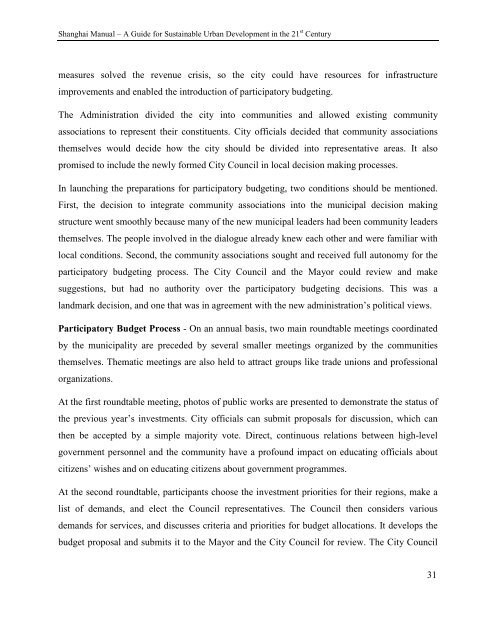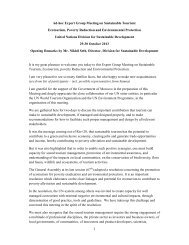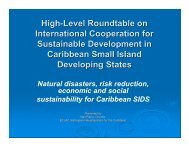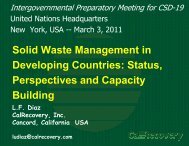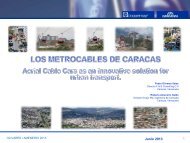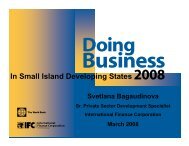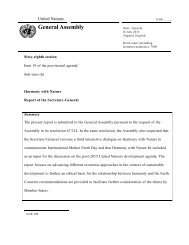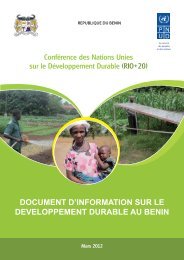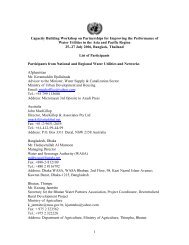- Page 2 and 3:
IntroductionShanghai ManualA Guide
- Page 4 and 5:
Introduction3FOREWORD - BUREAU INTE
- Page 6 and 7:
IntroductionFOREWORD - CITY OF SHAN
- Page 8 and 9:
IntroductionFinally we wish to appr
- Page 10 and 11:
IntroductionThe iconic China pavili
- Page 12 and 13:
Introductionwas always meant to be
- Page 14 and 15:
IntroductionWORLD EXPO 2010 SHANGHA
- Page 16 and 17: IntroductionTo Build a Smart and Ac
- Page 18 and 19: Shanghai Manual - A Guide for Susta
- Page 20 and 21: Shanghai Manual - A Guide for Susta
- Page 22 and 23: Shanghai Manual - A Guide for Susta
- Page 24 and 25: Shanghai Manual - A Guide for Susta
- Page 26 and 27: Shanghai Manual - A Guide for Susta
- Page 28 and 29: Shanghai Manual - A Guide for Susta
- Page 30 and 31: Shanghai Manual - A Guide for Susta
- Page 33 and 34: Envisioning a Harmonious City with
- Page 35 and 36: Envisioning a Harmonious City with
- Page 37 and 38: Delivering Effective Urban Manageme
- Page 39 and 40: Delivering Effective Urban Manageme
- Page 41 and 42: Delivering Effective Urban Manageme
- Page 43 and 44: Delivering Effective Urban Manageme
- Page 45 and 46: Delivering Effective Urban Manageme
- Page 47 and 48: Delivering Effective Urban Manageme
- Page 49 and 50: Delivering Effective Urban Manageme
- Page 51 and 52: Delivering Effective Urban Manageme
- Page 53 and 54: Delivering Effective Urban Manageme
- Page 55 and 56: Delivering Effective Urban Manageme
- Page 57 and 58: Delivering Effective Urban Manageme
- Page 59 and 60: Delivering Effective Urban Manageme
- Page 61 and 62: Delivering Effective Urban Manageme
- Page 63 and 64: Delivering Effective Urban Manageme
- Page 65: Delivering Effective Urban Manageme
- Page 69 and 70: Delivering Effective Urban Manageme
- Page 71 and 72: Delivering Effective Urban Manageme
- Page 73 and 74: Delivering Effective Urban Manageme
- Page 75 and 76: Delivering Effective Urban Manageme
- Page 77 and 78: Transforming the Urban Economymanag
- Page 79 and 80: Transforming the Urban Economymanuf
- Page 81 and 82: Transforming the Urban Economycarbo
- Page 83 and 84: Transforming the Urban Economy2.2.
- Page 85 and 86: Transforming the Urban Economylimit
- Page 87 and 88: Transforming the Urban Economy3. CA
- Page 89 and 90: Transforming the Urban EconomyExpor
- Page 91 and 92: Transforming the Urban EconomyHisto
- Page 93 and 94: Transforming the Urban EconomyThe m
- Page 95 and 96: Transforming the Urban Economy3.3.
- Page 97 and 98: Transforming the Urban EconomySouth
- Page 99 and 100: Transforming the Urban EconomyAs on
- Page 101 and 102: Transforming the Urban Economycombi
- Page 103 and 104: Transforming the Urban EconomyPolic
- Page 105 and 106: Transforming the Urban Economy“Ci
- Page 107 and 108: Sustainable Urban Transportelements
- Page 109 and 110: Sustainable Urban Transport1.2 URBA
- Page 111 and 112: Sustainable Urban TransportIn fact,
- Page 113 and 114: Sustainable Urban Transportconvenie
- Page 115 and 116: Sustainable Urban Transportreductio
- Page 117 and 118:
Sustainable Urban TransportCaption:
- Page 119 and 120:
Sustainable Urban Transportstart us
- Page 121 and 122:
Sustainable Urban Transportlow inco
- Page 123 and 124:
Sustainable Urban TransportThe city
- Page 125 and 126:
Sustainable Urban TransportEnrique
- Page 127 and 128:
Sustainable Urban Transportwhile sp
- Page 129 and 130:
Sustainable Urban Transportcycling,
- Page 131 and 132:
Sustainable Urban Transportneed to
- Page 133 and 134:
Sustainable Urban TransportAn addit
- Page 135 and 136:
Sustainable Urban TransportThis sch
- Page 137 and 138:
Sustainable Urban TransportThe LEZ
- Page 139 and 140:
Sustainable Urban Transport- Net re
- Page 141 and 142:
Sustainable Urban TransportPolicy O
- Page 143 and 144:
Sustainable Urban TransportAsian De
- Page 145 and 146:
Municipal Solid Waste ManagementAs
- Page 147 and 148:
Municipal Solid Waste ManagementFig
- Page 149 and 150:
Municipal Solid Waste ManagementFig
- Page 151 and 152:
Municipal Solid Waste ManagementBox
- Page 153 and 154:
Municipal Solid Waste Management・
- Page 155 and 156:
Municipal Solid Waste ManagementSou
- Page 157 and 158:
Municipal Solid Waste Managementbei
- Page 159 and 160:
Municipal Solid Waste Managementinc
- Page 161 and 162:
Municipal Solid Waste Managementof
- Page 163 and 164:
Municipal Solid Waste Management3.
- Page 165 and 166:
Municipal Solid Waste ManagementThe
- Page 167 and 168:
Municipal Solid Waste Management3.2
- Page 169 and 170:
Municipal Solid Waste Managementbe
- Page 171 and 172:
Municipal Solid Waste ManagementMin
- Page 173 and 174:
Municipal Solid Waste Management3.4
- Page 175 and 176:
Municipal Solid Waste Managementper
- Page 177 and 178:
Municipal Solid Waste ManagementStr
- Page 179 and 180:
Municipal Solid Waste Management8.
- Page 181 and 182:
Green Buildings for a Resource Effi
- Page 183 and 184:
Green Buildings for a Resource Effi
- Page 185 and 186:
Green Buildings for a Resource Effi
- Page 187 and 188:
Green Buildings for a Resource Effi
- Page 189 and 190:
Green Buildings for a Resource Effi
- Page 191 and 192:
Green Buildings for a Resource Effi
- Page 193 and 194:
Green Buildings for a Resource Effi
- Page 195 and 196:
Green Buildings for a Resource Effi
- Page 197 and 198:
Green Buildings for a Resource Effi
- Page 199 and 200:
Green Buildings for a Resource Effi
- Page 201 and 202:
Green Buildings for a Resource Effi
- Page 203 and 204:
Embracing Scientific and Technologi
- Page 205 and 206:
Embracing Scientific and Technologi
- Page 207 and 208:
Embracing Scientific and Technologi
- Page 209 and 210:
Embracing Scientific and Technologi
- Page 211 and 212:
Embracing Scientific and Technologi
- Page 213 and 214:
Embracing Scientific and Technologi
- Page 215 and 216:
Embracing Scientific and Technologi
- Page 217 and 218:
Embracing Scientific and Technologi
- Page 219 and 220:
Embracing Scientific and Technologi
- Page 221 and 222:
Embracing Scientific and Technologi
- Page 223 and 224:
Embracing Scientific and Technologi
- Page 225 and 226:
Embracing Scientific and Technologi
- Page 227 and 228:
Shanghai Manual - A Guide for Susta
- Page 229 and 230:
Shanghai Manual - A Guide for Susta
- Page 231 and 232:
Shanghai Manual - A Guide for Susta
- Page 233 and 234:
Shanghai Manual - A Guide for Susta
- Page 235 and 236:
Shanghai Manual - A Guide for Susta
- Page 237 and 238:
Shanghai Manual - A Guide for Susta
- Page 239 and 240:
Shanghai Manual - A Guide for Susta
- Page 241 and 242:
Shanghai Manual - A Guide for Susta
- Page 243 and 244:
Shanghai Manual - A Guide for Susta
- Page 245 and 246:
Shanghai Manual - A Guide for Susta
- Page 247 and 248:
Shanghai Manual - A Guide for Susta
- Page 249 and 250:
Shanghai Manual - A Guide for Susta
- Page 251 and 252:
Shanghai Manual - A Guide for Susta
- Page 253 and 254:
Shanghai Manual - A Guide for Susta
- Page 255 and 256:
Shanghai Manual - A Guide for Susta
- Page 257 and 258:
Fostering Culturally Rich Communiti
- Page 259 and 260:
Fostering Culturally Rich Communiti
- Page 261 and 262:
Fostering Culturally Rich Communiti
- Page 263 and 264:
Fostering Culturally Rich Communiti
- Page 265 and 266:
Fostering Culturally Rich Communiti
- Page 267 and 268:
Fostering Culturally Rich Communiti
- Page 269 and 270:
Fostering Culturally Rich Communiti
- Page 271 and 272:
Fostering Culturally Rich Communiti
- Page 273 and 274:
Fostering Culturally Rich Communiti
- Page 275 and 276:
Fostering Culturally Rich Communiti
- Page 277 and 278:
Fostering Culturally Rich Communiti
- Page 279 and 280:
Fostering Culturally Rich Communiti
- Page 281 and 282:
Fostering Culturally Rich Communiti
- Page 283 and 284:
Fostering Culturally Rich Communiti
- Page 285 and 286:
Shanghai Manual - A Guide for Susta
- Page 287 and 288:
Shanghai Manual - A Guide for Susta
- Page 289 and 290:
Shanghai Manual - A Guide for Susta
- Page 291 and 292:
Shanghai Manual - A Guide for Susta
- Page 293 and 294:
Shanghai Manual - A Guide for Susta
- Page 295 and 296:
Shanghai Manual - A Guide for Susta
- Page 297 and 298:
Shanghai Manual - A Guide for Susta
- Page 299 and 300:
Shanghai Manual - A Guide for Susta
- Page 301 and 302:
Shanghai Manual - A Guide for Susta
- Page 303 and 304:
Shanghai Manual - A Guide for Susta
- Page 305 and 306:
Shanghai Manual - A Guide for Susta
- Page 307 and 308:
Shanghai Manual - A Guide for Susta
- Page 309 and 310:
Shanghai Manual - A Guide for Susta
- Page 311 and 312:
Shanghai Manual - A Guide for Susta
- Page 313 and 314:
Shanghai Manual - A Guide for Susta
- Page 315 and 316:
Shanghai Manual - A Guide for Susta
- Page 317 and 318:
Shanghai Manual - A Guide for Susta
- Page 319 and 320:
Shanghai Manual - A Guide for Susta


